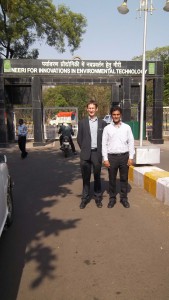Previously, when anyone mentioned Nagpur to me, I’d immediately think of oranges, searing summer heat (> 40 °C), and Haldiram’s! Well, I’ll now include another item to that list – environmental research!

Last month, I went to Nagpur along with Dr. Philip Earis from the Royal Society of Chemistry (RSC) to visit the National Environmental Engineering Research Institute (NEERI). The institute has five zonal laboratories located across Chennai, Mumbai, New Delhi, Hyderabad, and Kolkata. Each zonal institute caters to the local needs by leveraging the research capabilities centralised in Nagpur.
All the research disciplines pursued at the institute, obviously, pertain to environmental conservation including environmental audit, environmental biotechnology, water technology and management, environmental impact & risk assessment, environmental materials, environmental genomics, solid & hazardous waste management, and environmental system design and modelling.
One of NEERI’s mission projects under the 12th Five Year Plan is clean water, which aligns well with one of the challenges (energy-water-food nexus) identified under the anticipated Newton fund for India. In the UK, the Engineering and Physical Sciences Research Council (EPSRC), in partnership with industry, has jointly funded an industrial doctoral centre (STREAM) specifically for the water sector. This programme is being implemented by five academic centres of excellence in water science and engineering.
Deservedly, the NEERI hosts the Stockholm Convention Regional Centre in India. In line with the Stockholm Convention, the centre conducts research and development towards the effective management of persistent organic pollutants (POPs), which are carbon-based chemical substances harmful to both humans and wildlife.
Particularly, we visited the laboratories of Dr. Amit Bansiwal and Dr. G. Saravanan in the Environmental Materials division, headed by Dr. Sadhana Rayalu. The division pursues several research areas including catalytic materials, clean energy, carbon capture, and soil remediation.
Interestingly, Dr. G. Saravanan recently joined the institute after spending over a decade in Japan as a researcher. Sugoi!* This reminded me of my own memorable, short stint in Japan as a visiting doctoral student!
Then, Philip and I had a roundtable discussion with the researchers at the institute. While I spoke about the activities of the UK Science & Innovation Network in India, Philip informed the audience about the RSC’s various journals, and best practices for publishing in those journals.
Lastly, we met with the Director of NEERI, Dr. S. R. Wate, who told us about the national level contributions of NEERI including training programmes offered by the institute in environmental impact assessment.
On our way back to the airport, we popped into Haldiram’s flagship store, located at a stone’s throw from the institute, and picked up a couple of boxes of delicious orange burfee! My tryst with searing Nagpur literally ended on a sweet note!
*‘Sugoi’ in Japanese means amazing.
